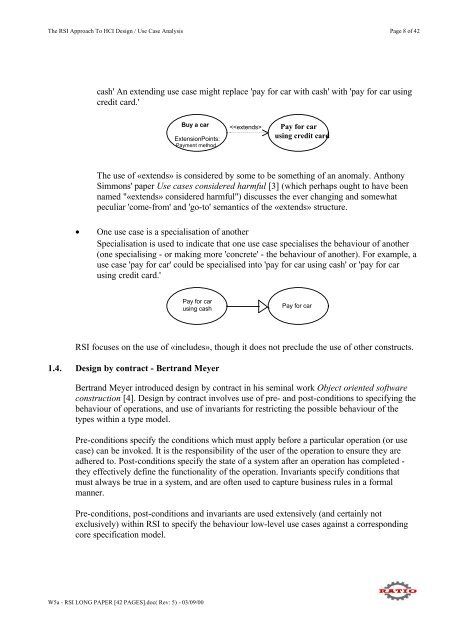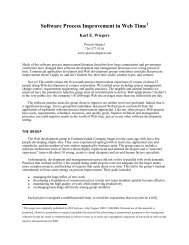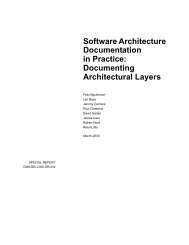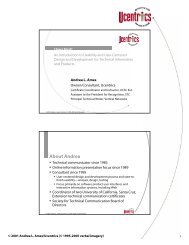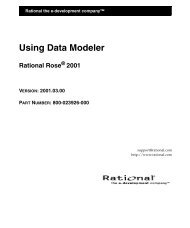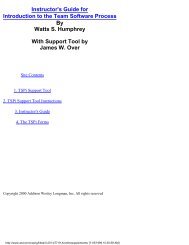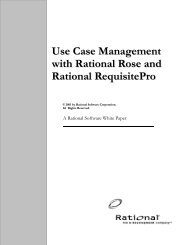RSI - A Structured Approach Use Cases and HCI Design
RSI - A Structured Approach Use Cases and HCI Design
RSI - A Structured Approach Use Cases and HCI Design
You also want an ePaper? Increase the reach of your titles
YUMPU automatically turns print PDFs into web optimized ePapers that Google loves.
The <strong>RSI</strong> <strong>Approach</strong> To <strong>HCI</strong> <strong>Design</strong> / <strong>Use</strong> Case Analysis Page 8 of 42<br />
cash' An extending use case might replace 'pay for car with cash' with 'pay for car using<br />
credit card.'<br />
Buy a car<br />
ExtensionPoints:<br />
Payment method<br />
W5a - <strong>RSI</strong> LONG PAPER [42 PAGES].doc( Rev: 5) - 03/09/00<br />
<br />
Pay for car<br />
using credit card<br />
The use of «extends» is considered by some to be something of an anomaly. Anthony<br />
Simmons' paper <strong>Use</strong> cases considered harmful [3] (which perhaps ought to have been<br />
named "«extends» considered harmful") discusses the ever changing <strong>and</strong> somewhat<br />
peculiar 'come-from' <strong>and</strong> 'go-to' semantics of the «extends» structure.<br />
• One use case is a specialisation of another<br />
Specialisation is used to indicate that one use case specialises the behaviour of another<br />
(one specialising - or making more 'concrete' - the behaviour of another). For example, a<br />
use case 'pay for car' could be specialised into 'pay for car using cash' or 'pay for car<br />
using credit card.'<br />
Pay for car<br />
using cash<br />
Pay for car<br />
<strong>RSI</strong> focuses on the use of «includes», though it does not preclude the use of other constructs.<br />
1.4. <strong>Design</strong> by contract - Bertr<strong>and</strong> Meyer<br />
Bertr<strong>and</strong> Meyer introduced design by contract in his seminal work Object oriented software<br />
construction [4]. <strong>Design</strong> by contract involves use of pre- <strong>and</strong> post-conditions to specifying the<br />
behaviour of operations, <strong>and</strong> use of invariants for restricting the possible behaviour of the<br />
types within a type model.<br />
Pre-conditions specify the conditions which must apply before a particular operation (or use<br />
case) can be invoked. It is the responsibility of the user of the operation to ensure they are<br />
adhered to. Post-conditions specify the state of a system after an operation has completed -<br />
they effectively define the functionality of the operation. Invariants specify conditions that<br />
must always be true in a system, <strong>and</strong> are often used to capture business rules in a formal<br />
manner.<br />
Pre-conditions, post-conditions <strong>and</strong> invariants are used extensively (<strong>and</strong> certainly not<br />
exclusively) within <strong>RSI</strong> to specify the behaviour low-level use cases against a corresponding<br />
core specification model.


